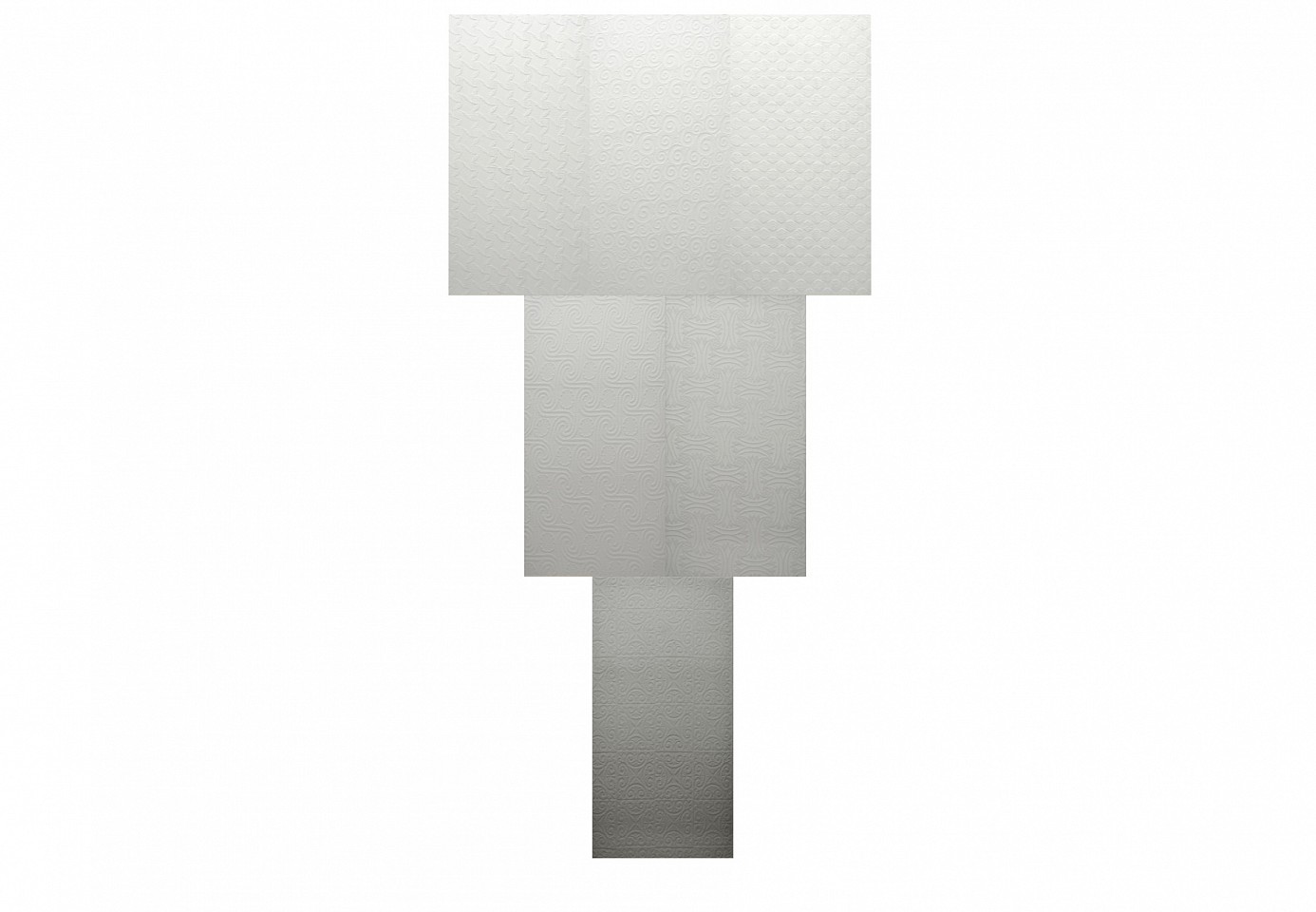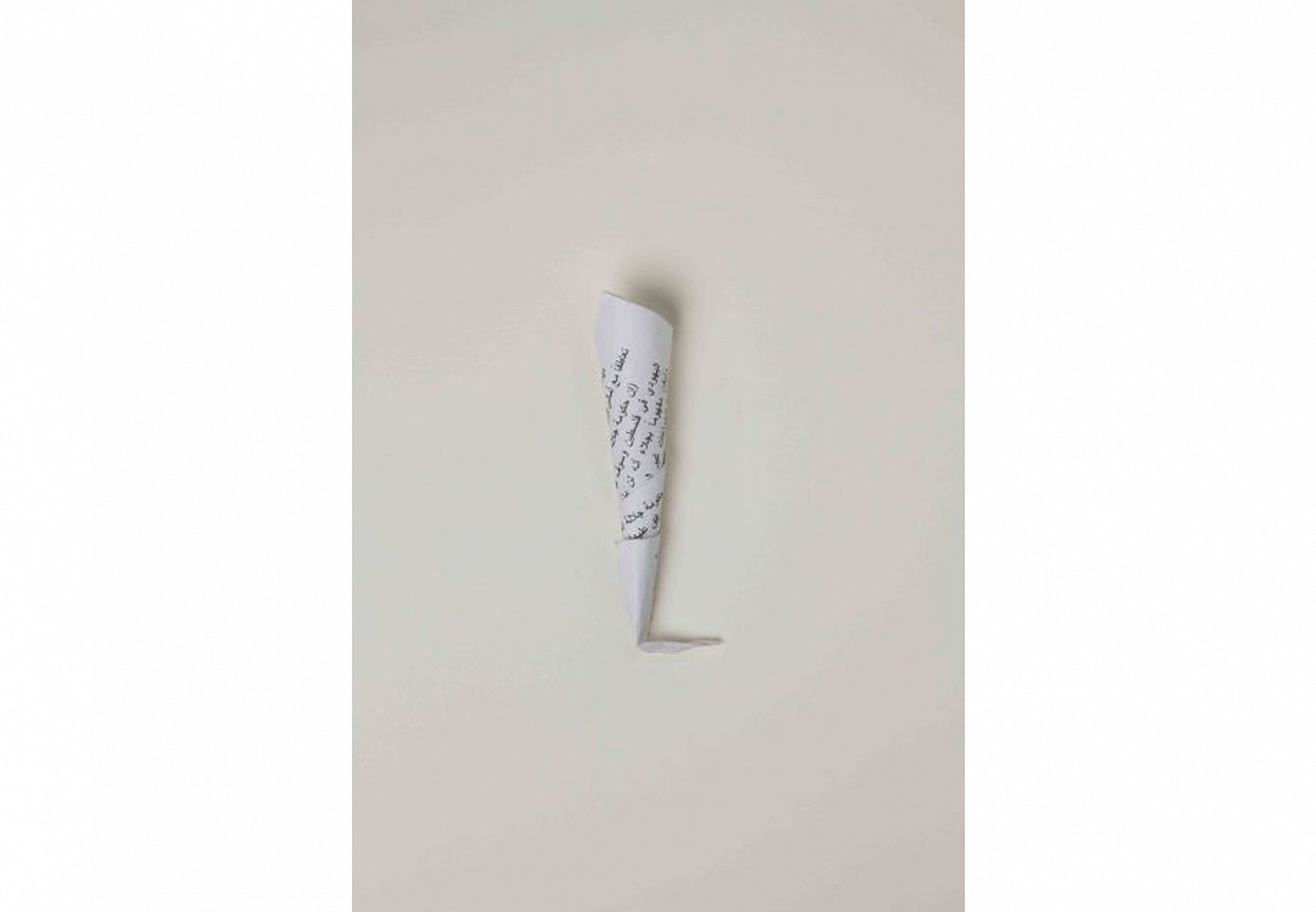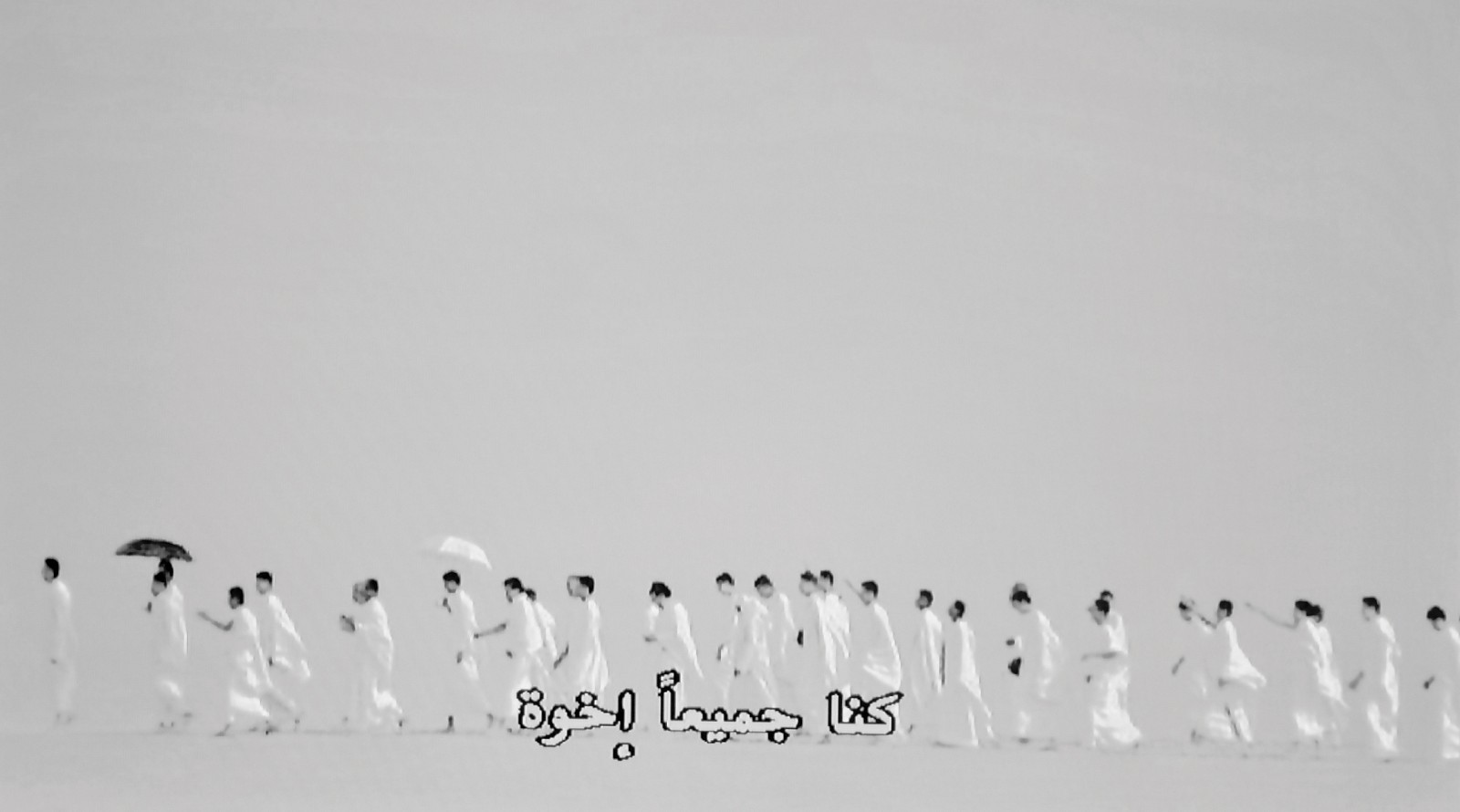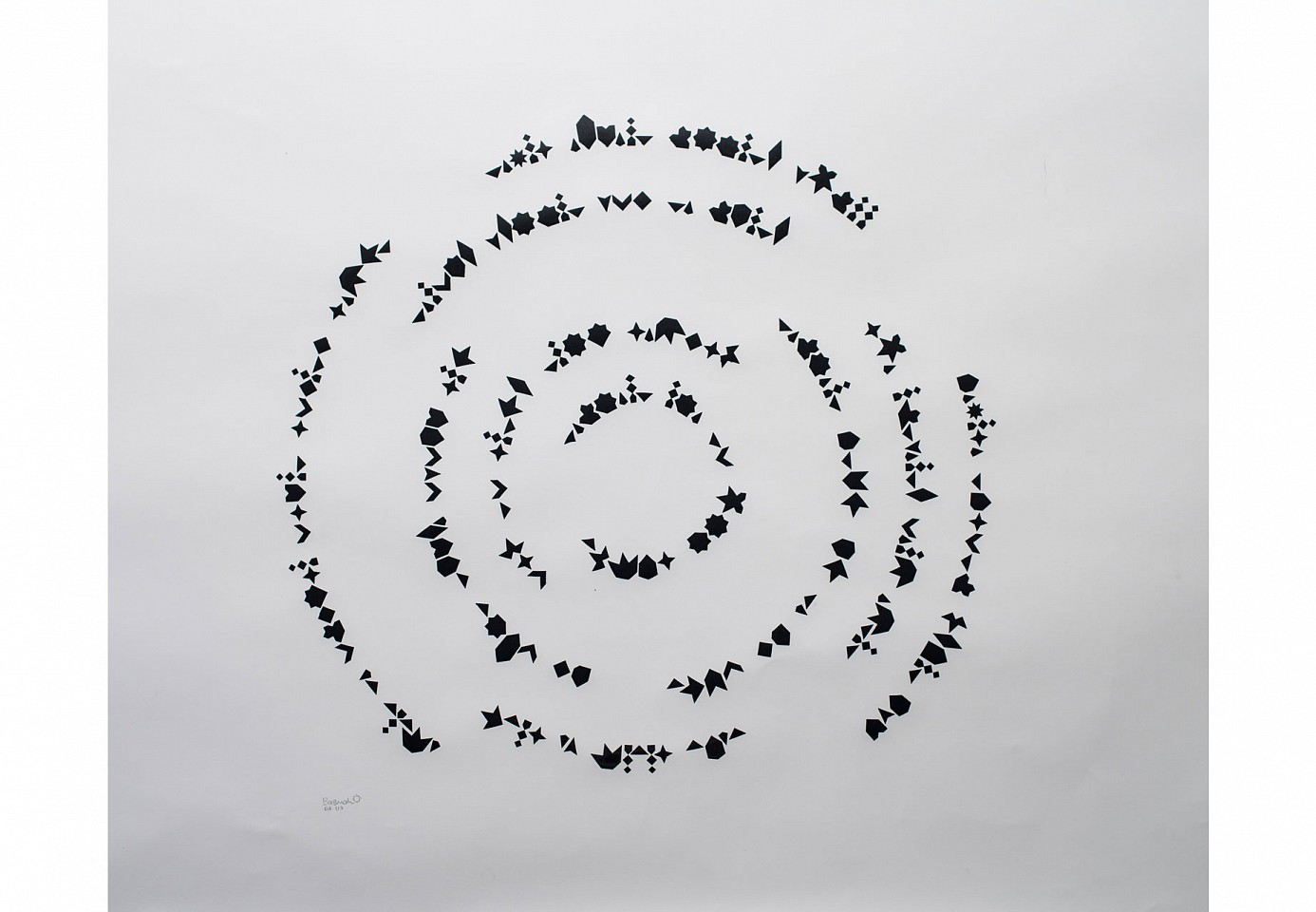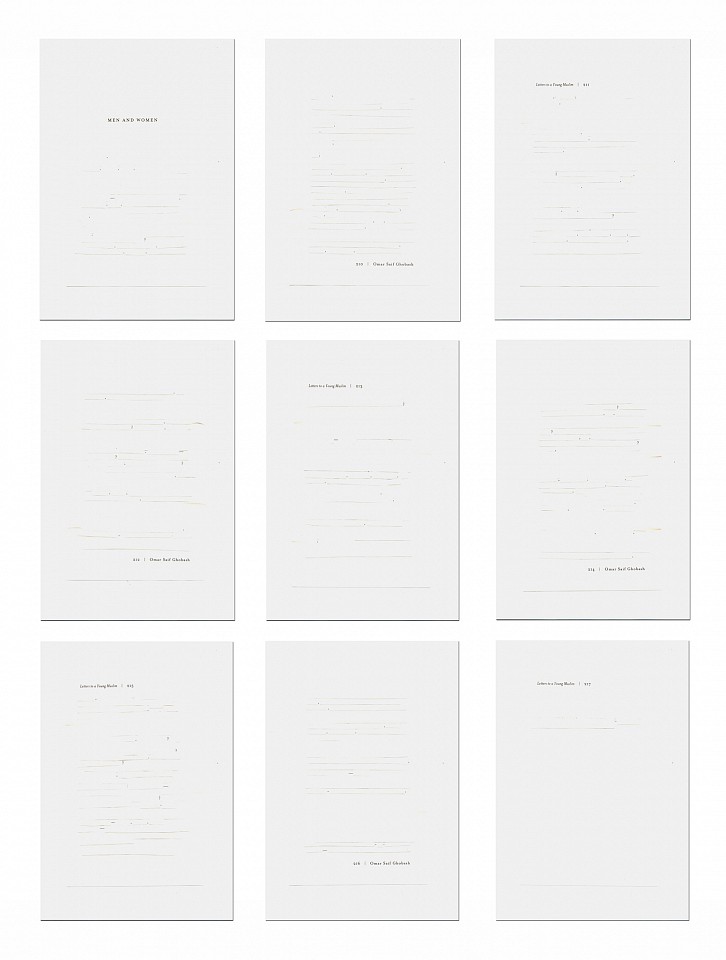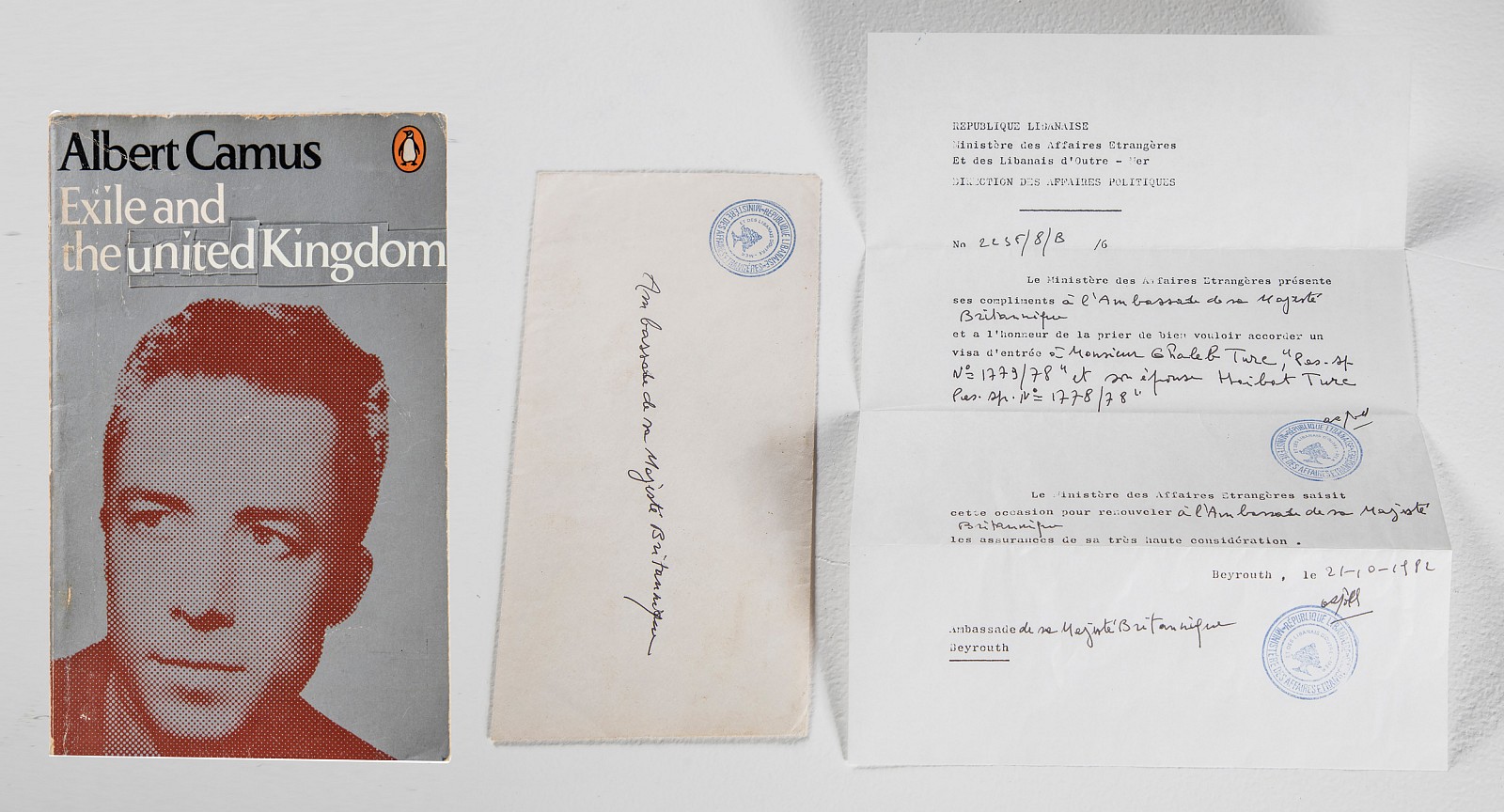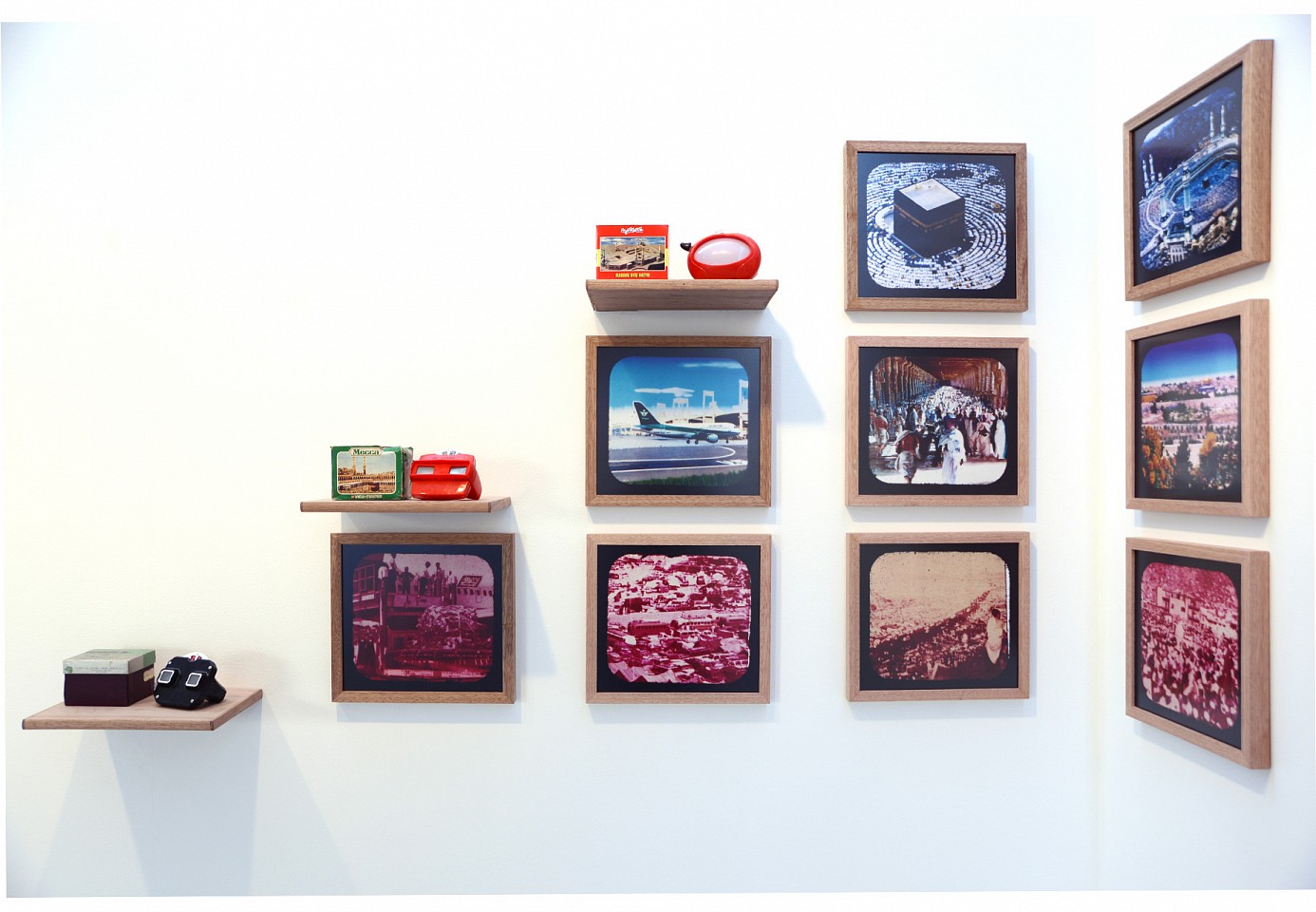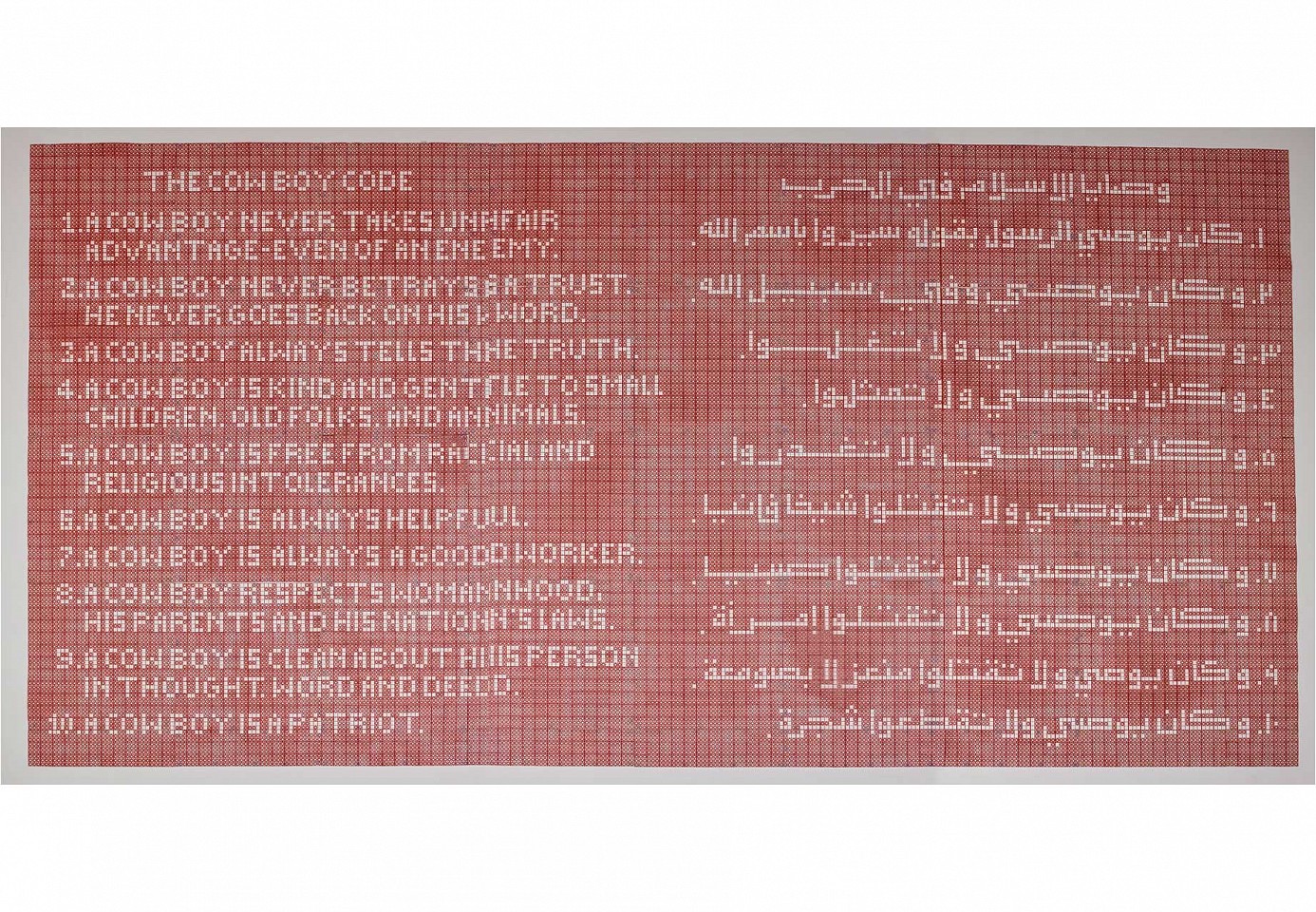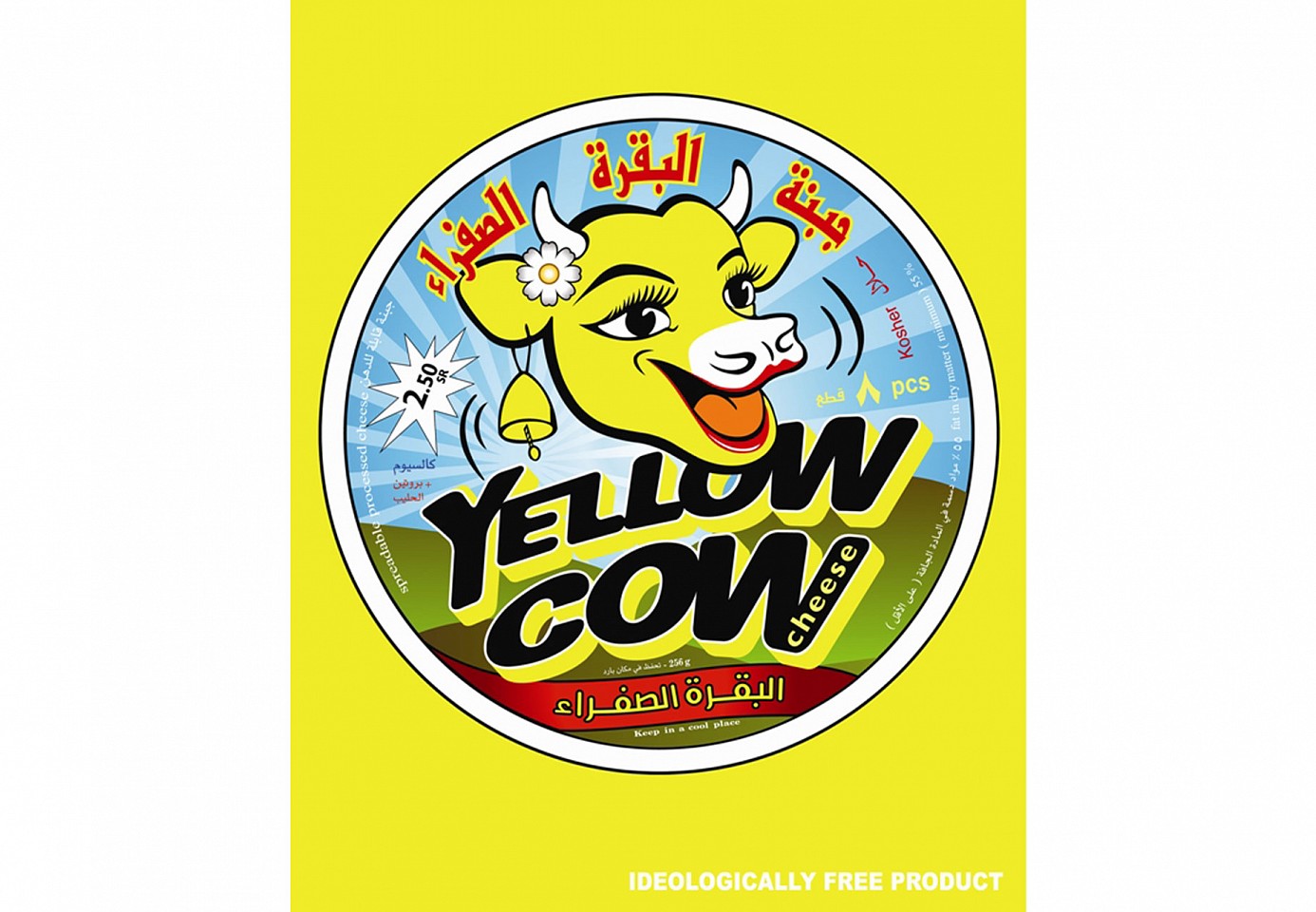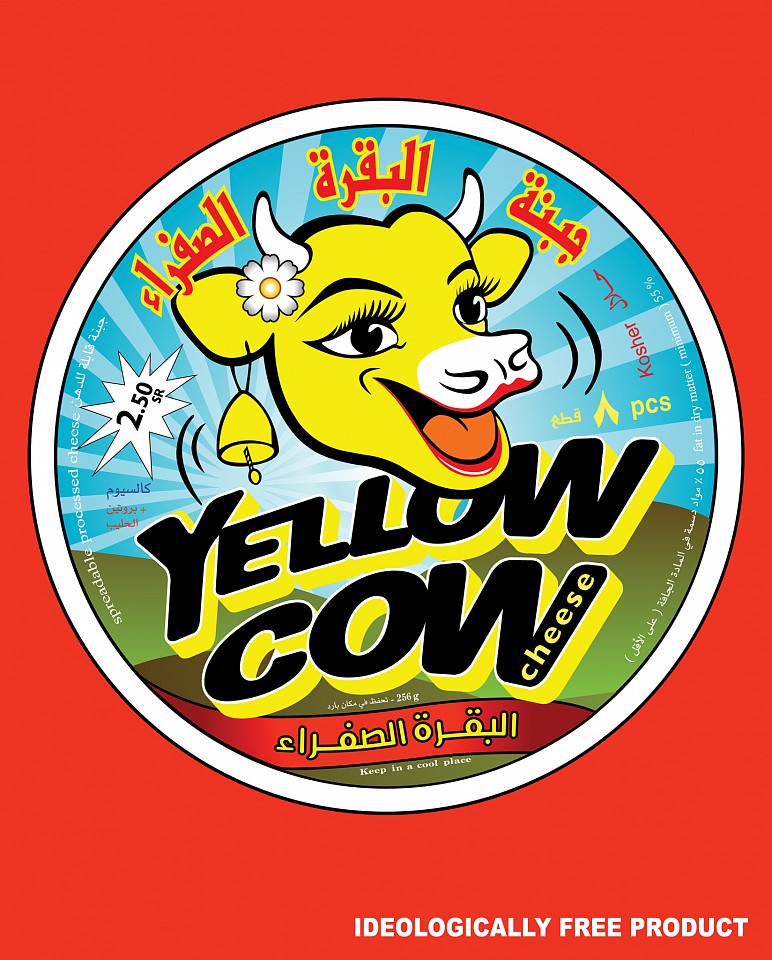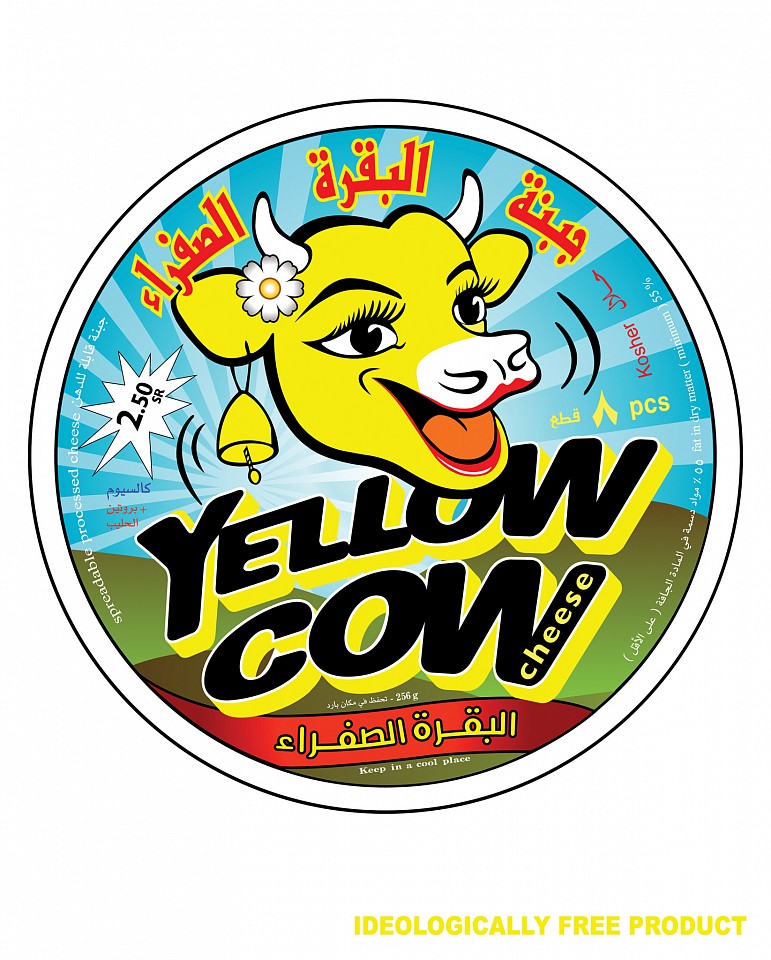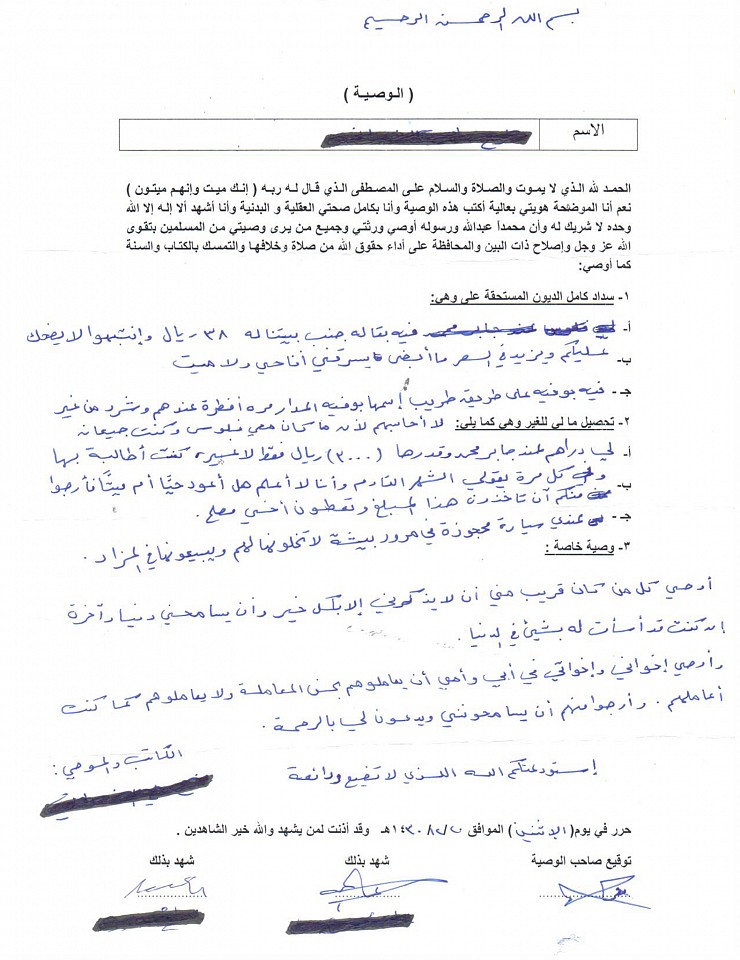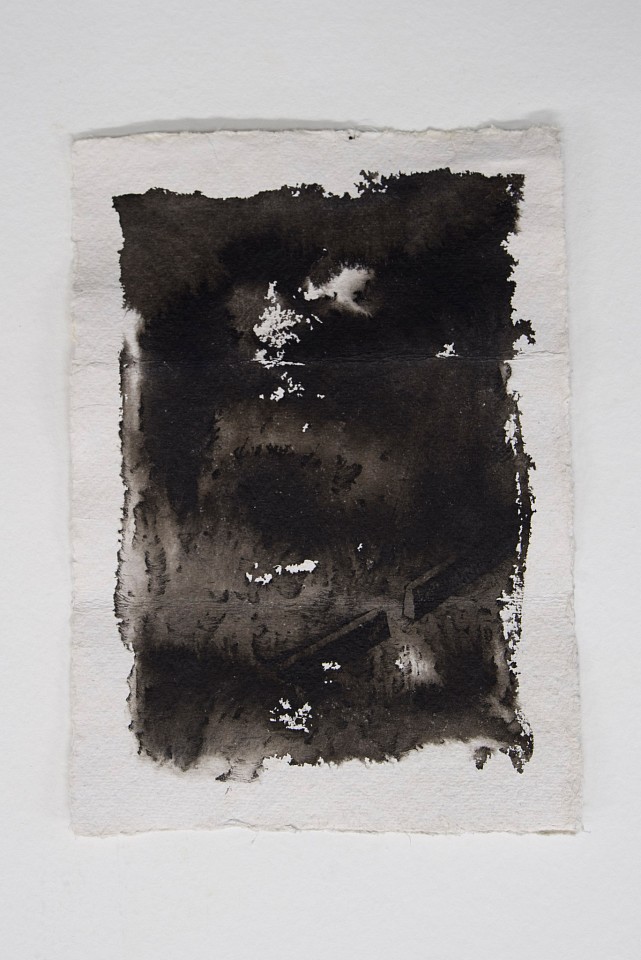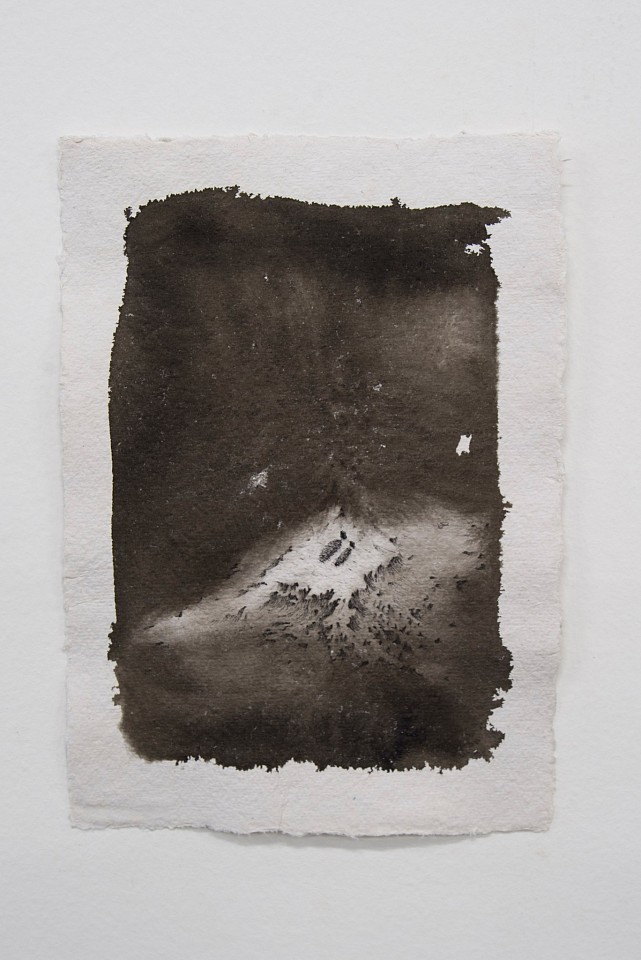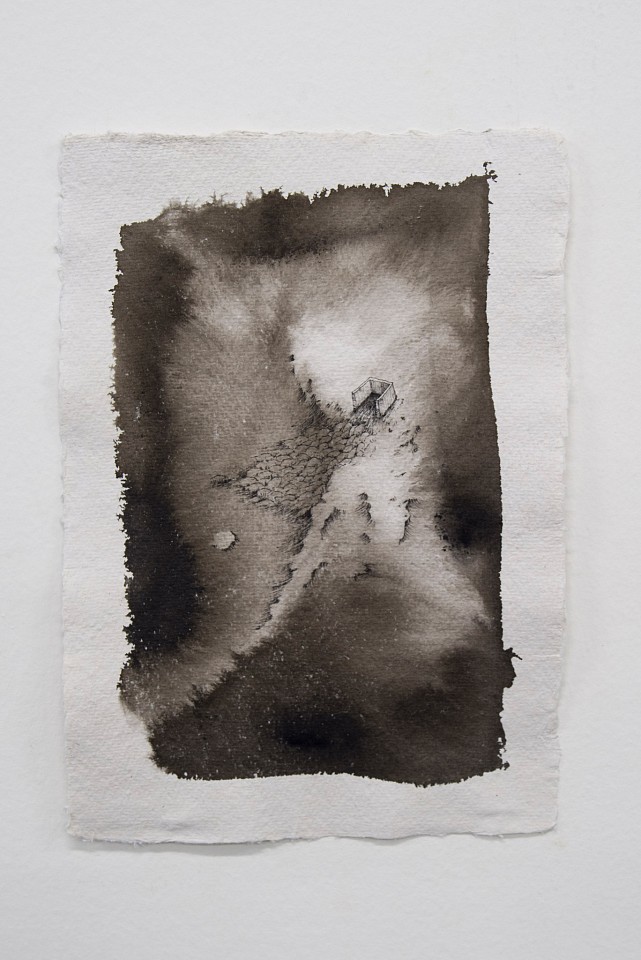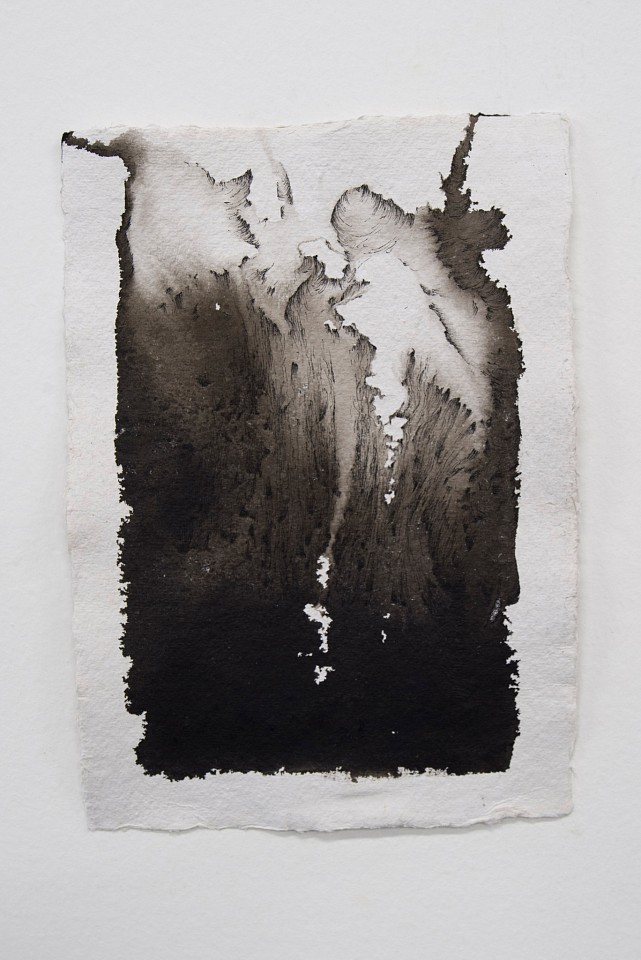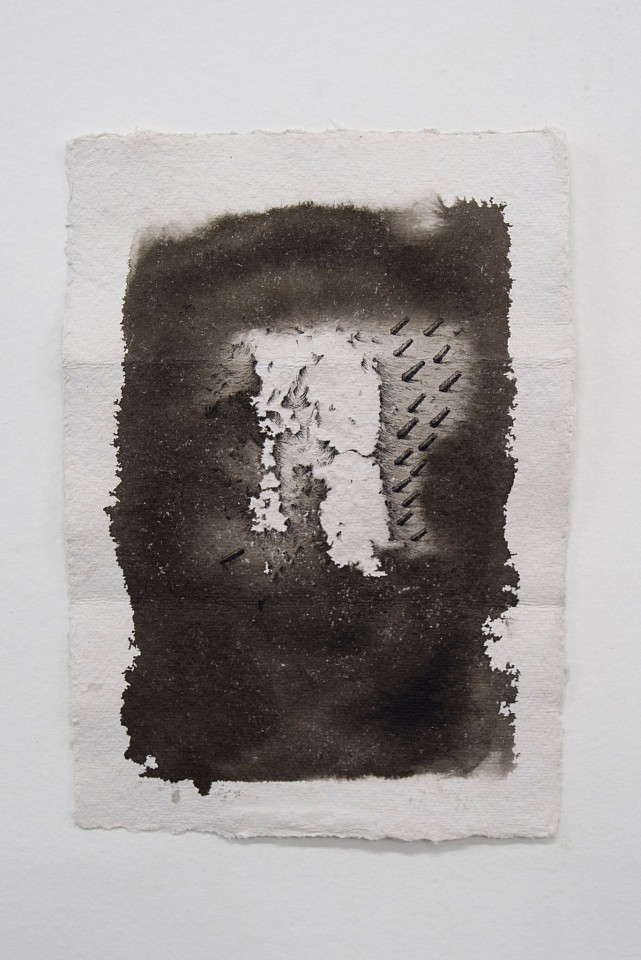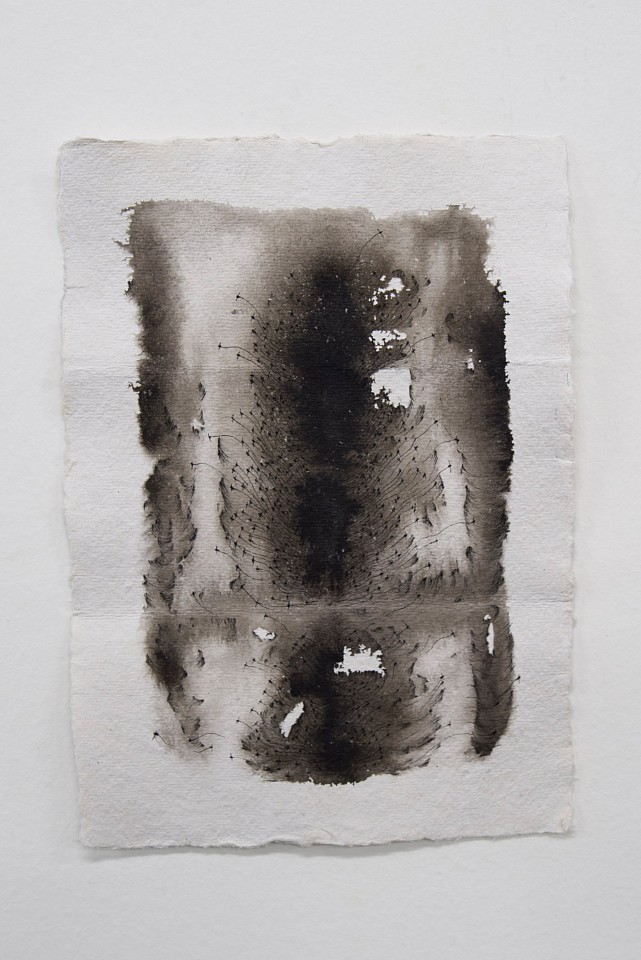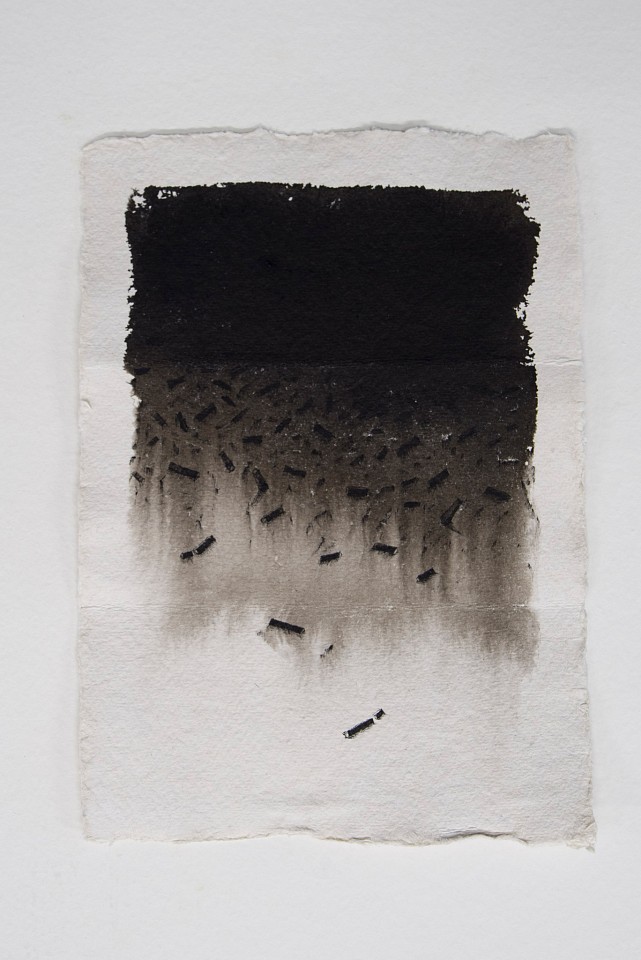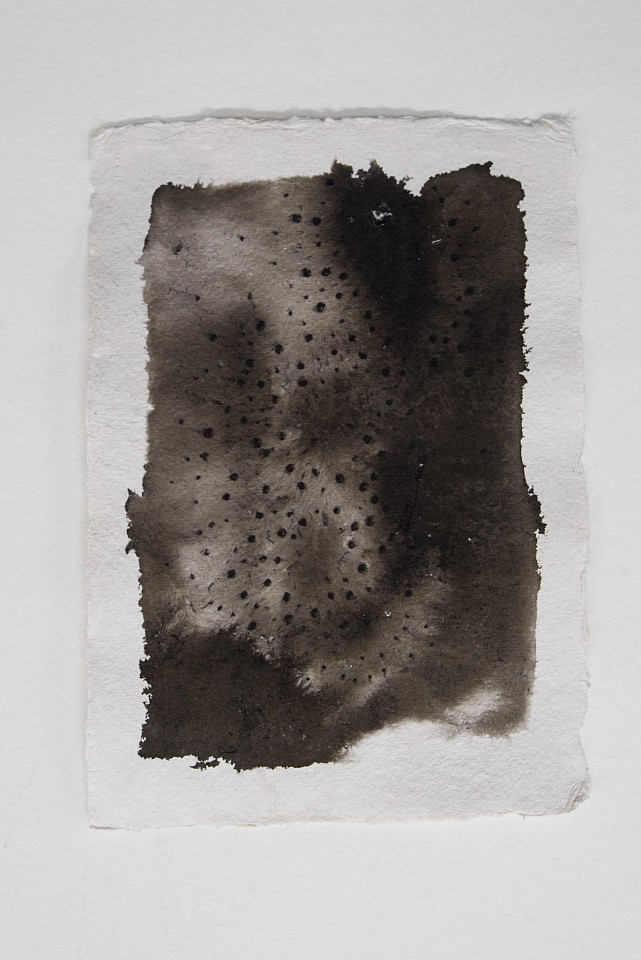Daniah Al Saleh
Restitution, 2017
watercolor, gouache, acrylic on paper
DAS0025
Nasser Al Salem
Arabi/Gharbi, 2016
Neon Installation
96.7 x 217.2 cm
Dana Awartani
All [heavenly bodies] swim along, each in its orbit, 2016
Mixed Media
150 x 150 cm
Ayman Yossri Daydban
Ra'i from Ihramat, 2012
Stretched Ihram Fabric over Wooden Frame
240 x 480 cm (94 1/2 x 189 in.)
AYD0396
Ayman Yossri Daydban
Balfour Declaration, 2011
100% Cotton Acid Free Paper
77 x 56 cm (30 3/8 x 22 in.)
AYD0428
Ayman Yossri Daydban
Kunna Jameean Ekhwa, 2010
B&W Lithograph
AYD0301
Basmah Felemban
Qif Bil Tawaf, 2014
Work on paper
65 x 65 cm (25 9/16 x 25 9/16 in.)
Edition of 3 + 1 AP; From the Last Seen...series
BAF0017
Aya Haidar
Full Stop, 2017
Altered Book Pages
AYH0079
Aya Haidar
Exile and the United Kingdom, 2016
Book and Diplomatic Letter
AYH0064
Ahmed Mater
View Masters and Slides Installation, 2014
3 various View Masters
24 C- prints, 40 x 40 cm each
Edition of 10 Image courtesy of Sharjah Art Foundation
AHM0204
Ahmed Mater
Cowboy Code II, 2012
Plastic Gun Powder Caps
400 x 800 cm (157 7/16 x 314 15/16 in.)
AHM0231
Ahmed Mater
Yellow Cow Poster, 2010
Mixed Media
142 x 114 cm (55 7/8 x 44 7/8 in.)
Edition of 35
AHM0001
Ahmed Mater
Yellow Cow Poster (red), 2010
Mixed Media
AHM0310
Ahmed Mater
Yellow Cow Poster (white), 2010
Mixed Media
AHM0308
Abdulkarim Qassem
Wills of War 3, 2015
Work on paper
ABQ0002
Abdulkarim Qassem
Wills of War 5, 2015
Work on paper
ABQ0004
Muhannad Shono
2003 Al-Hamra Compound Attack, Riyadh, Saudi Arabia from the series Return to Sender, 2017
Ink on Paper
MSH0053
Muhannad Shono
2005 Killing of Moustapha Akkad, His Daughter and 58 Other People, Amman, Jordan from the series Return to Sender, 2017
Ink on Paper
MSH0054
Muhannad Shono
2013 Sana'a Attack, Al-Oraidi Hospital Sana'a Yemen from the series Return to Sender, 2017
Ink on Paper
MSH0055
Muhannad Shono
2014 Death of Aitzaz Hassan_Government High School_Hangu District, Pakistan_from the series Return to Sender, 2017
Ink on Paper
MSH0056
Muhannad Shono
2015 Killing of Avijit Roy, Ekushe Book Fair, Dhaka, Bangladesh from the series Return to Sender, 2017
Ink on Paper
MSH0057
Muhannad Shono
2015 Sousse Attacks, Riu Imperial Marhaba and Soviva, Port El Kantaoui,Sousse, Tunisia from the series Return to Sender, 2017
Ink on Paper
MSH0058
Muhannad Shono
2016 Deir ez-Zor Massacre Deir ez-Zor, Syria from the series Return to Sender, 2017
Ink on Paper
MSH0059
Muhannad Shono
2016 Nice Attack_Promenade des Anglaise_Nice, France from the series Return to Sender, 2017
Ink on Paper
MSH0060
Muhannad Shono
2017 Manchester Arena Bombing Manchester England from the series Return to Sender, 2017
Ink on Paper
MSH0061

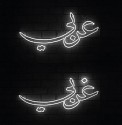
![Dana Awartani, All [heavenly bodies] swim along, each in its orbit
2016, Mixed Media](/images/29138_h125w125gt.5.jpg)






















Ihramaat is a concept born out of a defining tradition and custom adopted during the holy Hajj pilgrimage. In this series, Daydban uses authentic Ihramat, the customary white cloth worn by pilgrims to Makkah, stretched onto wooden frames and presents them in multiple variations. Traditionally, every man performing his pilgrimage is required to wear white cloth. It erases any distinguishing features between himself and his neighbor and presents them as one, stripped down to their purest form, all equal and united under the same faithful brotherhood.
At a distance, the ihram seems identical as they are of the same scale and essentially plain white cloth, but as you approach, distinct patterns begin to appear. Parallels can be drawn between the piece and social ideals, whereby each panel represents a building block in society. Various groups share differences and similarities in their patterning, yet work together under a grater umbrella to flow in peace and harmony.
View Master slides 1960-80 / 1980-2000 and 2000-2020
Images taken from Makkah’s most widely circulated pilgrim keepsake. Made in China since the pre-1960s they have been shipped over in their thousands along the same silk route that has been central to cultural interaction from East to West since 206 BCE. These same View Finders, once bought on Al Khalil Road in Makkah, are then disseminated through the hands of the pilgrims to every corner of the world. The View Finders and their images, are not only visual portals to a city that bristles under the weight of its own dramatic symbolism but a reflection of a site revered by millions created with the specific task of triggering fantasies of a pilgrimage to Makkah and all it implies. As objects, the View Finders embody these dreams, whilst the collection of images, once released from the limitations of their intended form, are transformed. They become not only social documentation but pertinent and poignant signifiers of specific times and places, drawing on collective history, iconography and memory, of a site that is at once the most visited yet the most exclusive in the world.
Ahmed Mater’s The Cowboy Code (2012), is a large-scale wall based installation of ten commandments, listed in Arabic and English using plastic toy gun caps. The commandments or codes are an appropriation of a song first performed by Gene Autry in the 40s.
The timeless character of the vagabonding cowboy is a persona once present throughout the pictures houses of Mater’s youth – a playful and frivolous character on the outside but with an almost inviolable moral core. For Mater, the cowboy is the nomad of the Western sands, much like the Bedouin is the nomad of the Eastern sands. Through this work, the artist is seeking out what unites ‘us’ (East and West) rather than what sets us apart. He makes comparisons between the language of two codes of ethics, one from the American West and one from the Islamic code referring to statements or actions of the Prophet Muhammad (PBUH), known as the Hadith.
“When we were children, we often played with toy guns, and would buy the little red caps from the local shop. They were called ‘Western Gun Caps’. You could get them everywhere in Saudi Arabia. We imitated the cowboys we saw on television. Their language, their clothes, their values.”
The Cowboy Code
1 A cowboy never takes unfair advantage – even of an enemy.
2 A cowboy never betrays a trust. He never goes back on his word.
3 A cowboy always tells the truth.
4 A cowboy is kind and gentle to small children, old folks, and animals.
5 A cowboy is free from racial and religious intolerances.
6 A cowboy is always helpful when someone is in trouble.
7 A cowboy is always a good worker.
8 A cowboy respects womanhood, his parents and his nation’s laws.
9 A cowboy is clean about his person in thought, word, and deed.
10 A cowboy is a Patriot.
The Hadith (Translation)
1 The Prophet cautioned to always march in the name of God.
2 He cautioned to always march in the path of God.
3 He cautioned never to be extreme or fanatic.
4 He cautioned never to desecrate the bodies of your fallen enemy.
5 He cautioned never to take unfair advantage of your enemy.
6 He cautioned never to harm the elderly.
7 He cautioned never to harm children.
8 He cautioned never to harm women.
9 He cautioned never to harm holy men.
10 He cautioned never to cut down trees.
“Over the course of ten years, our lives changed completely. It is a drastic change that I experience every day. The Cowboy Code is something I have thought about for years. When I was a child, the cowboy was always a symbol of freedom and adventure, an ideology that came from the West and assimilated itself into my culture. Like many of my generation, I have taken a lot from the West – the food we eat, clothes we wear, even our language and so I wanted to present this code as a way of reclaiming these qualities as opposed to purely commodity driven influences. I want to move these compatible beliefs away from the politics, from the media and give them back to the people.”
-Ahmed Mater
Yellow Cow is a series of interventions, performances and installations inspired by a passage in the Surah Al- Baqarah (The Cow), which is the longest chapter in the Qur’an. Mater explains, “The stories I heard in the Qur’an study group were the main stories of my daily life. They were like a guide.”
Yellow Cow is not a work of art that seeks resolution. It is an ongoing project that literally and figuratively places this ancient story into contemporary consumer society. To date, the project has been realised as a film, a shop installation, a brand and a series of products, all asking the same question posed by the story in the Qur’an: what is so special about this yellow cow?
YELLOW COW PERFORMANCE: Ahmed conceived his first Yellow Cow performance just to see how people would react. He went to a farm and, using saffron-based dye, coloured a white cow yellow before setting it free in the village. He then watched the delighted reactions of the villagers, which reminded him of the stirrings of his own imagination as a child in the mosque.
YELLOW COW BRAND: Believing the Yellow Cow was as relevant now as it has ever been, Ahmed decided to “set the story free.” He wanted to release the messages held within the Surah – kept alive in mosques and Qur’anic study groups for 1300 years – into the contemporary world. In order to make the story relevant to people’s lives in the 21st century, he created a brand and initiated a ‘line extension’ of mass-produced Yellow Cow cheese, butter, yoghurt and milk products – flooding the market and giving it a material presence in people’s homes, workplaces and local shops.
Ahmed explains, “In biblical and Quranic times a story was spread by word of mouth and recitation; to spread a story… or an ideology… in the contemporary world, one has to conceive a brand which will be recognizable in the marketplace.”
Omar Saif Ghobash's 'letters' to his 'young Muslim' [son] serves as the pivot around which 36 artists respond to in this latest exhibition.Â
Â
In the contemporary globalized world we live in, shaped by money, military and media, finding space to value the authentic and interpret the unadulterated is a feat in and of itself. Each chapter presents a personal letter from Ghobaish to his son, based on an aspect of Islam prevalently misunderstood and misinterpreted in wider society. Ghobash carefully unpicks it factually based on his immediate life-experience. What simmers to the top are fine bubbles of wisdom, open mindedness and judiciousness, adhering firmly to the forward thinking and openness of Islam.
Â
Our latest exhibition takes the themes explored in Ghobash’s book as the basis from which 36 international artists present works- be it as a direct commentary, themed inspiration or candid response- where each work will be sub categorized into its own respective group. The ventured topics interweave their multilayers and overlap thematically.
Â
The groups include; Fragments of Memory, Landscapes, Youth and Other, Probable Questions, Power of Language and The Grey Area. This cross-fertilization within each sub-category generates waves of dialogue, further emphasizing the conceptual depth and breadth of the continued interpretation of religion in today's world.
Â
Participating Artists Include:
Abdulkarim Qasim - Abdullah Al Othman - Abdulnasser Gharem - Ahaad Al Amoudi - Ahmed Mater - Anahita Razmi - Arwa Abouon - Aya Haidar - Ayman Yossri Daydban - Ayman Zedani - Babak Golkar - Basma Felemban - Dana Awartani  -Daniah Al Saleh - Driss Ouadahi -  Eiman Elgibreen - Fahad Burki - Faycal Baghriche - Hajra Waheed - Hazem Harb - James Clar - Joseph Rodriguez  - Jowhara Al Saud - Lulwah Al Homoud - Manal Al Dowayan -  Muhannad Shono  -Nadine Hammam - Nasser Al-Salem - Rayyane Tabet - Saeed Gamhawi - Sara Abdu - Sara Rahbar - Ushmita Sahu - Yara El-Sherbini - Zahrah Al GhamdiÂ


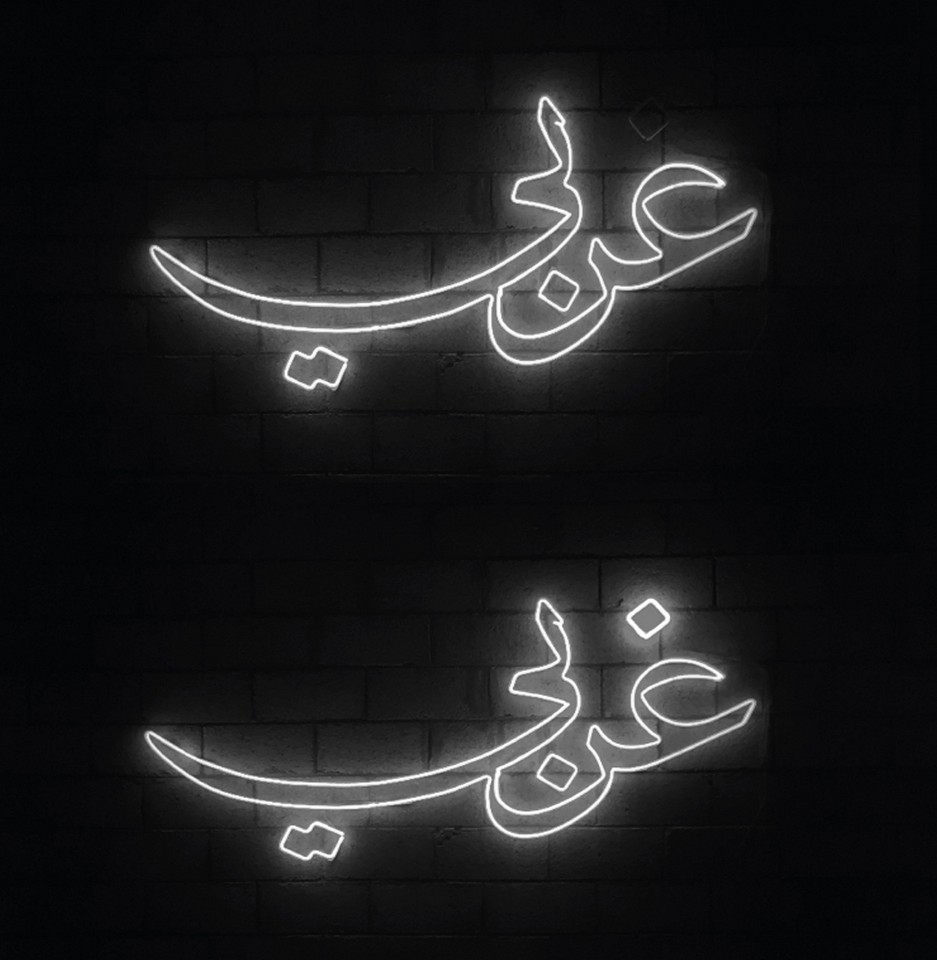
![<p><span class="viewer-caption-artist">Dana Awartani</span></p>
<p><span class="viewer-caption-title"><i>All [heavenly bodies] swim along, each in its orbit</i></span>, <span class="viewer-caption-year">2016</span></p>
<p><span class="viewer-caption-media">Mixed Media</span></p>
<p><span class="viewer-caption-dimensions">150 x 150 cm</span></p>
<p><span class="viewer-caption-aux"></span></p>](/images/29138_h960w1600gt.5.jpg)
